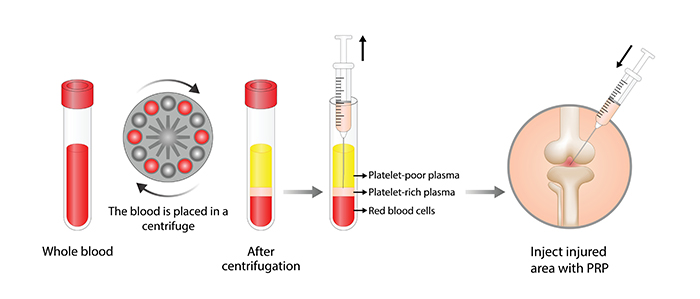Platelet Rich Plasma (PRP) for Foot and Ankle Injuries
PRP is a revolutionary treatment that harnesses the power of the patient’s own blood platelets to promote healing and tissue regeneration. PRP injections could provide better pain relief and functional outcomes than other treatments for persons presenting with common foot and ankle injuries.
PRP (Platelet-Rich Plasma) is a regenerative medicine therapy that involves the use of a patient’s own blood plasma to promote healing and regeneration of tissues. Blood is composed of several components, including red blood cells, white blood cells, plasma, and platelets.
Platelets are small cells in the blood that play a crucial role in the body’s natural healing process by helping to form blood clots to stop bleeding and by releasing growth factors that stimulate the cells that promote tissue repair.
The growth factors and other proteins present in PRP stimulate and accelerate healing by attracting stem cells and other repair cells to the injured site, promoting tissue regeneration, and reducing inflammation. PRP therapy has been used to treat a variety of conditions, including arthritis, tendonitis, ligament sprains, muscle strains, and more.

A small amount of a patient’s blood is drawn and spun in a centrifuge to separate and concentrate the blood platelets. The concentrated platelets and growth factors are combined with the remaining blood and a local anesthetic for your comfort. This concentrated PRP solution is then injected, under ultrasound guidance, into the affected area of the patient’s body, such as a joint or muscle, to promote healing and tissue regeneration.
Side effects are minimal and may include pain at the site of injection that can last for a few hours or days and swelling that resolves within a few days. After treatment a patient will be advised to rest and avoid exercise for a time.
Generally, it can take up to a month to experience pain relief which will improve over the course of 3-6 months after treatment. However, the recovery period is determined by the type and severity of injury.
PRP has been used in the treatment of various shoulder injuries. Use is aimed at enhancing tissue healing, reducing pain, and improving functional outcomes. Below are key applications of PRP for shoulder injuries:
PRP therapy is considered for a range of foot and ankle conditions, including:
Tendon injuries, such as Achilles tendinopathy:
Chronic Achilles tendinopathy is a common and challenging condition to treat. PRP contains numerous growth factors that may accelerate healing and recovery. However, there is controversy about its benefits for patients with Achilles tendinopathy.
Bone and Cartilage lesions:
Studies found that PRP used with microfracture produced superior results in function and pain relief in small lesions when compared to surgery alone. One study also found that PRP was more effective at relieving symptoms than hyaluronic acid injection.
Plantar fasciitis:
Studies report that PRP is more effective than corticosteroid injections in addressing pain and improving function in plantar fasciitis.
Ankle sprains and ligament injuries:
The most request musculoskeletal injury in the physically active group is a ligament sprain. Early conservative management and functional rehabilitation are the mainstay of treatment. The addition of PRP appears to successfully treat pain which enables the patient to better participate in rehabilitation and recovery and provides better functioning.
Osteoarthritis affecting the foot and ankle joints:
OA of the foot and ankle typically results from trauma. Recent studies seem to indicate that platelet-rich plasma (PRP) therapy is more effective at reducing pain than hyaluronic acid. Patients treated with PRP reported less pain and better function.
The treatment outcomes can be influenced by factors such as the severity of the injury, patient’s age, overall health, and specific PRP preparation used. Dr. Ajay Lall may consider the use of PRP as part of a comprehensive treatment plan for ankle and foot injuries.
PRP therapy stimulates and accelerates tissue repair and healing without invasive procedures and the associated risks. PRP therapy may significantly improve your function and quality of life.
There are no safety concerns with PRP therapy, and most people experience a permanent reduction or elimination of pain and inflammation.
When you or a loved one suffers with an ankle or foot injury, contact Dr. Ajay Lall to schedule a consultation to receive the correct diagnosis and all your treatment options. We have office in Belvidere, Illinois, Paramus, New Jersey and Philadelphia, PA.
At a Glance
Ajay C. Lall, MD, MS, FAAOS
- Board Certified – Orthopedic Surgery
- Triple Fellowship Trained
- Performs over 750 Surgeries Per Year
- Learn more

